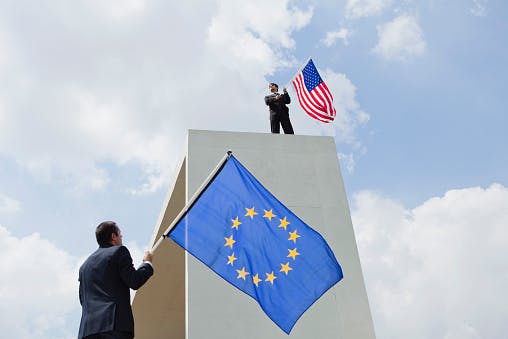The US now accounts for 20 of the world’s 25 most valuable companies — Europe only has 1
The AI boom has pushed US giants even higher.
The global corporate leaderboard is increasingly dominated by US firms, so much so that 80% of the world’s largest 25 companies are based in America. Conversely, Europe has just one single entrant squeaking onto the list — Dutch chip equipment maker ASML — landing at No. 25 as Europe’s highest-ranked representative, according to data from CompaniesMarketCap.com.
Zooming out, and the world’s top 100 list tilts even more heavily toward America: 58 US companies together make up $39 trillion in market value — roughly three-quarters (74.2%) of the total — followed by Asia-Pacific (13.2%), Europe (8.3%), and the Middle East (3.4%).
The main driver behind that dominance is the US-centric AI boom, with the BATMMAAN stocks — Big Tech’s leading eight — now worth a staggering $22.5 trillion, collectively.
Europe, by contrast, lacks comparable hyperscalers or chip designers to ride that AI wave. Its corporate heavyweights instead skew toward luxury and retail (LVMH, Hermès, and L’Oréal), industrials (Siemens, Shell, and Airbus), and pharmaceuticals (Roche, Novartis) — slower-growth sectors compared to tech. Adding to the continent’s strain is Novo Nordisk, once Europe’s crown jewel, which has erased more than 60% of its market value since its peak last year, as the Ozempic maker faces rising competition in the weight-loss drug space.
Indeed, the transatlantic gap has only widened over the past decade. According to PWC’s Global Top 100 Companies report, the combined market value of US companies among the top 100 was 2.6x Europe’s in Q1 2015, 4.5x in Q1 2020, and 7.6x in Q1 2025. At the time of writing, that gap has grown to almost 9x.
Of course, valuations don’t tell the full story, as they reflect investors’ expectations at least as much as, if not more than, earnings. In fact, the S&P 500 has never been this expensive, trading at ~23x forward earnings — near dot-com era highs — while Europe’s STOXX 600 trades at roughly 15x.
